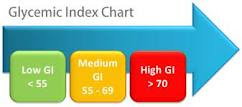The terms 'GI' and 'glycemic index' has become a buzzword in the health and nutrition circles. This Diabetes Awareness month the Good Life Dietitians help make GI easy for you.
What is the Glycemic Index?
The Glycemic index (GI) in simple terms is a measurement used to determine the speed at which a food or food product, when consumed, raises your blood glucose levels. If the food increases your blood glucose rapidly it is considered to be high GI. If a food is digested and absorbed more slowly, it causes a steadier increase in blood glucose levels and is considered to be low GI.
As we’ve established foods breakdown and release glucose into the blood stream at different rates. The glycaemic index ranges from 0 to 100, where 100 is taken to be pure glucose (or sugar). The effects of all other foods are then compared to that of glucose. A low GI food would be a food with a GI less than 55, an intermediate GI between 56 and 69, and a high GI higher than 70.
Why do I need the Glycemic Index?
The GI is not only beneficial for diabetics, as many may believe. Eating a low GI diet will cause slow and steady rises in blood glucose without creating sudden spikes or falls in your blood glucose, the result of which is you are left feeling very sluggish. Because low GI foods increase the blood sugar slow and steadily taking pressure is taken off the pancreas too produce high amounts of insulin.
Keeping this in mind you will have sustained energy and concentration throughout the day, improved physical energy and performance due to and stable blood glucose if you eat these low GI foods at regular intervals and in the right portions throughout the day.
Who can benefit from the GI?
- Insulin resistant and hyperinsulinemic patients
- Pre-diabetics
- Those who suffer from low blood glucose levels (hypoglycemia)
- Diabetics (type 1 and 2)
- Those aiming to lose weight
- Scholars, students and the work force who need optimal concentration and learning all day long
- Children and adults suffering from ADHD
- Athletes who need endurance and sustained energy over a longer period
- Those who suffer from heart disease
How do I incorporate GI in my everyday life?
Many foods are marked as high or low GI or their exact GI is indicated on the product. However, many will still not be indicated. Choose foods that are less refined and containing lots of fiber.
Factors that influence the GI may include the amount of cooking, amount of processing, size of the particles, type of fiber, acidity of the product, the presence of fat or protein and the type of sugar.
Keeping the above facts in mind, you should choose a starch product that:
- is cooked and processed as little as possible (close to it’s original state),
- has bigger particles (such as wholewheat kernels),
- contains soluble fiber (oat bran, legumes, beans)
- contains resistant starch, meaning that the body has difficulty processing the food, such as cooked and cooled starches
- contains acidic ingredients such as lemon juice or vinegar
- has a fat or protein combined with it to decrease the rate of absorption
For example:
Basmati rice has a low GI. When it is cooked and cooled the GI further lowers. By adding lentils you can further reduce the GI. Add a protein such as low-fat grilled chicken breast strips and finishing it off with lemon juice, olive oil and vinegar dressing for an example of a low GI meal. It has low GI starch, added soluble fiber, added acidity, protein and some healthy fats. Remember that even though it is low GI, you will still need to keep portion size in mind.
The low GI is a healthy way of eating for all individuals, not only those at risk of diabetes or any other disease and would be most beneficial when combined with a low fat diet. Look out for the GI rating on labels and follow these guidelines to make sure you compile low GI meals at home for yourself and your family.
For more information on the glycaemic index log onto the GI Foundation website.

This is awesome info! Is there a web site or link I can go to to find a list of low GI recipes for weight loss?
ReplyDeleteWe're so glad that you have found this post useful!
ReplyDeleteHere are some links for you:
- www.gifoundation.com (click on 'books' for a list of proudly South African low GI cookbooks which you can find at any Exclusive Books store)
- www.gabisteenkamp.co.za (a local dietitian and expert on the topic of GI)
- www.tastemag.co.za/Recipes.aspx (great recipe collection from the Woolworths Taste magazine, conviniently categorized e.g. health conscious, heart friendly, vegeterian, etc
- http://www.taste.com.au/recipes/collections/lower+gi
Hope this helps!